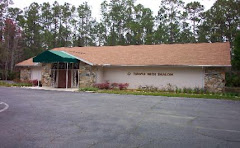
























The creation of the traditional Sukkah at Temple Beth Shalom was a "hands-on" experience for builders of every age! On the Sunday following Yom Kippur the faithful gathered to assemble the framework, complete the walls and cover the roof with sekhakh, the covering of vegetation that leaves Sukkah dwellers able to count the stars through the roof yet have half the floor in shade during the heat of the day.
The Torah tells us "You will dwell in booths for seven days; all natives of Israel shall dwell in booths" (Leviticus 23:42). In honor of the holiday's historical significance, we are commanded to dwell in temporary shelters, as our ancestors did in the wilderness. The temporary shelter is referred to as a sukkah (which is the singular form of the plural word "sukkot"). Like the word sukkot, it can be pronounced like Sue-KAH, or to rhyme with Book-a.
The sukkah is great fun for the children. Building the sukkah each year satisfies the common childhood fantasy of building a fort, and dwelling in the sukkah satisfies a child's desire to camp out in the backyard. The commandment to "dwell" in a sukkah can be fulfilled by simply eating all of one's meals there; however, if the weather, climate, and one's health permit, one should spend as much time in the sukkah as possible, including sleeping in it.
A sukkah must have at least two and a half walls covered with a material that will not blow away in the wind. Why two and a half walls? Look at the letters in the word "sukkah!" One letter has four sides, one has three sides and one has two and a half sides. The "walls" of the sukkah do not have to be solid; canvas covering tied or nailed down is acceptable and quite common in the United States. A sukkah may be any size, so long as it is large enough for you to fulfill the commandment of dwelling in it. The roof of the sukkah must be made of material referred to as sekhakh (literally, covering). To fulfill the commandment, sekhakh must be something that grew from the ground and was cut off, such as tree branches, corn stalks, bamboo reeds, sticks, or two-by-fours. Sekhakh must be left loose, not tied together or tied down. Sekhakh must be placed sparsely enough that rain can get in, and preferably sparsely enough that the stars can be seen, but not so sparsely that more than ten inches is open at any point or that there is more light than shade. The sekhakh must be put on last. Note: You may put a water-proof cover over the top of the sukkah when it is raining to protect the contents of the sukkah, but you cannot use it as a sukkah while it is covered and you must remove the cover to fulfill the Mitzvah, the commandment, of dwelling in a sukkah.
It is common practice, and highly commendable, to decorate the sukkah. In the northeastern United States, Jews commonly hang dried squash and corn in the sukkah to decorate it, because these vegetables are readily available at that time for the American holidays of Halloween and Thanksgiving. Many families hang artwork drawn by the children on the walls. Building and decorating a sukkah is a fun family project, much like decorating the Christmas tree is for Christians. It is a sad commentary on modern American Judaism that most of the assimilated Jews who complain about being deprived of the fun of having and decorating a Christmas tree have never even heard of Sukkot.
Many Americans, upon seeing a decorated sukkah for the first time, remark on how much the sukkah (and the holiday generally) reminds them of Thanksgiving. This may not be entirely coincidental: I was taught that our American pilgrims, who originated the Thanksgiving holiday, borrowed the idea from Sukkot. The pilgrims were deeply religious people. When they were trying to find a way to express their thanks for their survival and for the harvest, they looked to the Bible for an appropriate way of celebrating and found Sukkot. This is not the standard story taught in public schools today (that a Thanksgiving holiday is an English custom that the Pilgrims brought over), but the Sukkot explanation of Thanksgiving fits better with the meticulous research of Mayflower historian Caleb Johnson, who believes that the original Thanksgiving was a harvest festival (as is Sukkot), that it was observed in October (as Sukkot usually is), and that Pilgrims would not have celebrated a holiday that was not in the Bible (but Sukkot is in the Bible). Although Mr. Johnson claims that the first Thanksgiving was "not a religious holiday or observance," he apparently means this in a Christian sense, because he goes on to say that the first Thanksgiving was instead "a harvest festival that included feasts, sporting events, and other activities," concepts very much in keeping with the Jewish religious observance of Sukkot.
The Temple Beth Shalom Religious School endeavors to avoid separating students from the holidays of Jewish people. Religious School students were very much a part of the Sukkah building process.

No comments:
Post a Comment